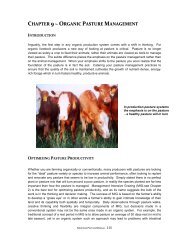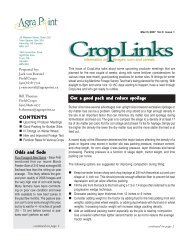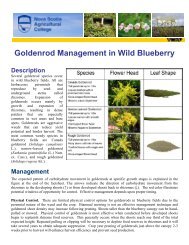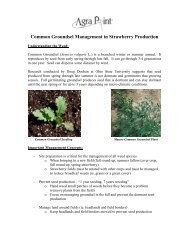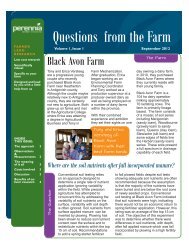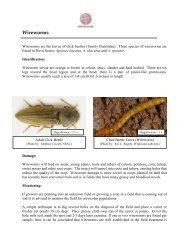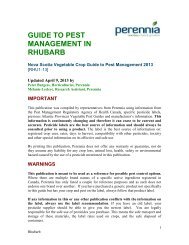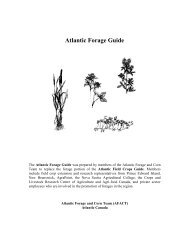Monitoring for Spotted Wing Drosophila - Perennia
Monitoring for Spotted Wing Drosophila - Perennia
Monitoring for Spotted Wing Drosophila - Perennia
Create successful ePaper yourself
Turn your PDF publications into a flip-book with our unique Google optimized e-Paper software.
Extension and Advisory Team<br />
<strong>Monitoring</strong> <strong>for</strong><br />
<strong>Spotted</strong> <strong>Wing</strong> <strong>Drosophila</strong><br />
Introduction<br />
<strong>Spotted</strong> <strong>Wing</strong> <strong>Drosophila</strong> (SWD) is a small (2-3 mm) invasive vinegar fly,<br />
established in several Provinces across Canada (BC, Ontario, Quebec, NB,<br />
PEI and NS). It can cause significant damage on a wide range of soft fruit,<br />
including: wild blueberry, highbush blueberry, strawberry (Day neutral and<br />
June bearing), raspberry, blackberry, cherries, peaches, plums, gooseberries,<br />
currants, grapes and a wide variety of wild and native fruits.<br />
Damage<br />
SWD does its damage by laying eggs in ripening fruit. The larvae quickly<br />
develop and feed on the inside of the fruit. Once this happens, it decreases<br />
harvestable yield and destroys the marketability of the fruit. During midsummer,<br />
when temperatures are warmer, the fly’s life cycle can shorten to<br />
less than 10 days. This leads to exponential population growth in the late<br />
summer and fall, which can have big impacts on marketable yields if they are<br />
not managed.<br />
The key to managing SWD involves trapping, to determine when the adults<br />
first appear in a field. The flies are not in commercial fields until the fruit<br />
starts to ripen. It is believed that they spend most of their time, early in the<br />
year, building up their population on wild and native fruits.<br />
Fig. 1 SWD male<br />
“ Once a fly is captured, treatment<br />
should begin <strong>for</strong> all susceptible<br />
crops in that area.”<br />
Fig. 2 SWD in a trap<br />
Based on experience from across the country and throughout North America,<br />
it is prudent to start a control program when the first male fly is captured in<br />
a commercial field.<br />
The PMRA is in the process of approving five products <strong>for</strong> “emergency<br />
use” <strong>for</strong> all soft fruit in Canada (Ripcord, Delegate, Malathion, Entrust and<br />
Pyganic). Check <strong>for</strong> the updated guide “Emergency Registrations <strong>for</strong> <strong>Spotted</strong><br />
<strong>Wing</strong> <strong>Drosophila</strong> – 2013” on the <strong>Perennia</strong> website <strong>for</strong> rates and pre-harvest<br />
intervals.<br />
Fig. 3 SWD female<br />
Identifying SWD<br />
For monitoring purposes we are looking <strong>for</strong> the male. The male (Figure 1)<br />
has red eyes and a single spot on the tip of each wing. Figure 2 shows a trap<br />
that has many SWD males, caught on the edge of a strawberry field in the<br />
middle of September 2012. Figure 3 shows a female fly; you can clearly see<br />
the serrated ovipositor. This ovipositor can be hard to see in the field and to<br />
the naked eye other types of drosophila may look similar.
<strong>Monitoring</strong> SWD: How many traps?<br />
Thresholds and monitoring protocols are still being developed,<br />
so there are no exact recommendations <strong>for</strong> numbers<br />
of traps. However, the more traps you have the better the<br />
chance you have to catch a fly. It comes down to what is<br />
practical <strong>for</strong> your operation. A three acre strawberry field<br />
could have many traps that could be checked in an hour,<br />
once a week. A wild blueberry operation that has many<br />
fields spread over a large area, might go <strong>for</strong> fewer traps per<br />
field or trap in representative fields in each area.<br />
What kind of traps?<br />
There are many types of traps that could be used and most<br />
are effective. What is outlined below is a conservative trap<br />
but it is simple and inexpensive to use. It will allow growers<br />
to easily and effectively monitor <strong>for</strong> this pest and to approximate<br />
when the fly begins to enter a field. This will allow<br />
the grower to determine when to begin applying control<br />
measures on their fields.<br />
Materials<br />
- 16-24 oz plastic beer cups with lids<br />
- A roll of red tuck tape or red duct tape (you don’t need<br />
this if you can find red plastic cups)<br />
SWD are attracted to red<br />
- A roll of electrical tape (this helps with contrast <strong>for</strong> the<br />
fly, so they can find the holes)<br />
- A single hole punch (1/4 inch holes)<br />
- Apple cider vinegar (ACV) research shows a yeast/sugar<br />
mixture is slightly better, particularly earlier in the season,<br />
but it is very difficult to work with.<br />
Step 1: Wrap the cup in red tape<br />
Step 2: Wrap the top inch or so of the cup with black electrical<br />
tape<br />
Step 3: Punch 7 or 8 holes through the black tape and cup<br />
with a single hole punch<br />
Step 4: Attach a cup holder to a wooden stake (This could<br />
be a 4 inch pot or an improvised devise to hold the cup in<br />
place)<br />
Step 5: Place trap in pairs, one in the tree line or hedgerow<br />
and one up to 50 metres into a field (shorter distance <strong>for</strong><br />
smaller fields). Place them about 1 metre off the ground in<br />
a protected areas. In low growing crops (ie. strawberry and<br />
wild blueberry) placing the traps closer to the crop canopy<br />
may be beneficial.<br />
Step 6: Fill cups 1/3 full with ACV<br />
Check traps on a weekly basis starting just after berries begin<br />
to ripen. For blueberry growers it is a good idea to place<br />
them near blueberry maggot traps <strong>for</strong> efficiency reasons. The<br />
apple cider vinegar should be dumped and replaced in each<br />
trap every week.<br />
Note – Pouring the ACV and flies into a white, flat plastic<br />
container (ie. Tupperware) will make looking <strong>for</strong> SWD much<br />
easier. There will be many other insects present in the trap.<br />
Controls<br />
Once a fly is captured, treatment should begin <strong>for</strong> all susceptible<br />
crops in that area. It should be done on a weekly basis,<br />
with particular caution given to rotating between different<br />
products and with concern <strong>for</strong> pre harvest intervals. Check<br />
the <strong>Perennia</strong> website <strong>for</strong> “Emergency Registrations <strong>for</strong> <strong>Spotted</strong><br />
<strong>Wing</strong> <strong>Drosophila</strong> – 2013” <strong>for</strong> applicable PHI’s.<br />
Resources<br />
For detailed in<strong>for</strong>mation on this pest, check out this website<br />
from Ontario. It also has links to other websites from across<br />
North America.<br />
http://www.omafra.gov.on.ca/english/crops/insects/drosophila.html<br />
For more in<strong>for</strong>mation, contact:<br />
Peter Burgess, Horticulture Crops Specialist<br />
Extension and Advisory Services Team<br />
<strong>Perennia</strong><br />
Tel: (902)896-0277<br />
Email: pburgess@perennia.ca<br />
Fig 4. Homemade SWD trap<br />
Photo Credits: Fig. 1 & Fig. 3 - Dr. Deb Moreau, AAFC<br />
Fig. 2 & Fig. 4 - Peter Burgess, <strong>Perennia</strong><br />
May 2013



